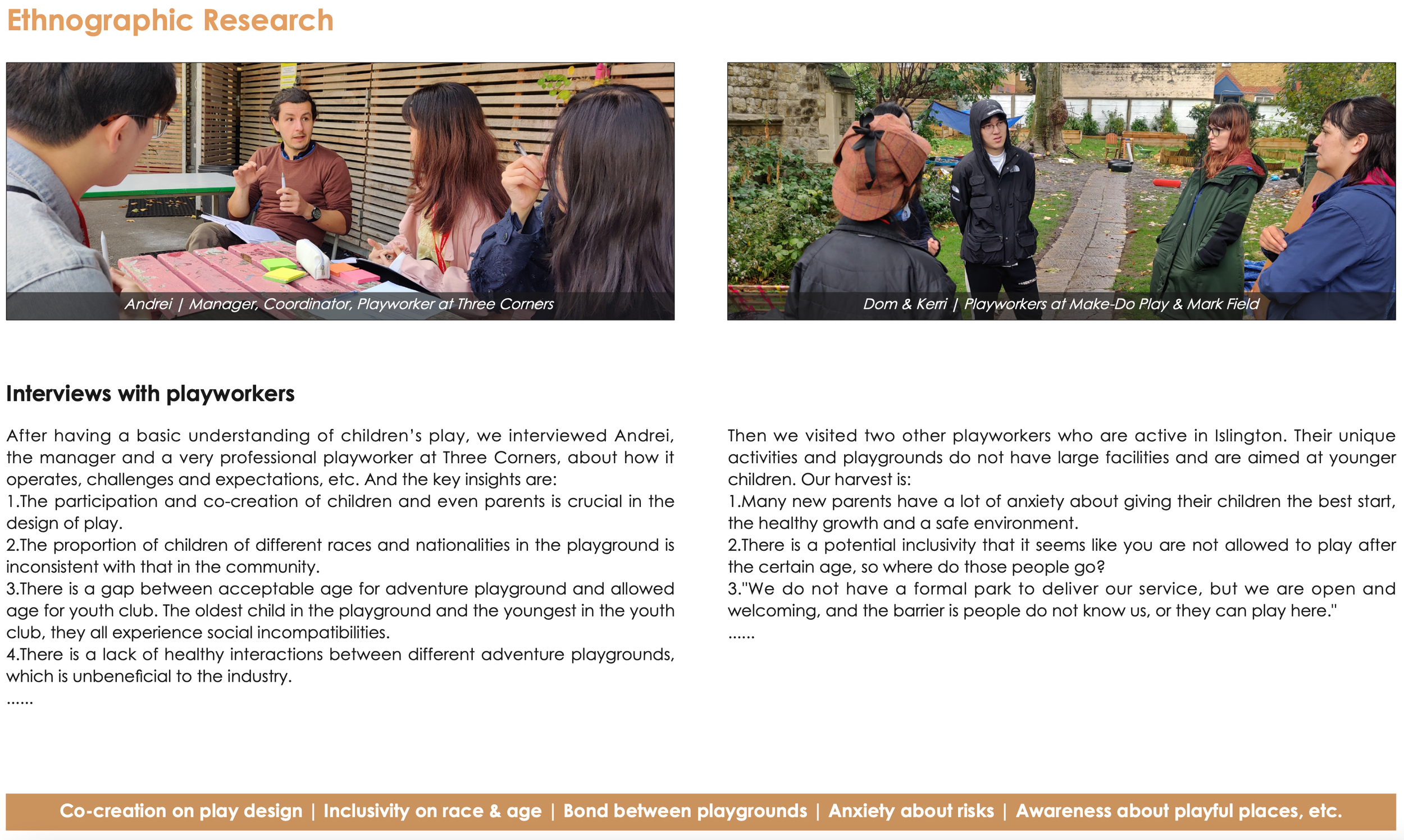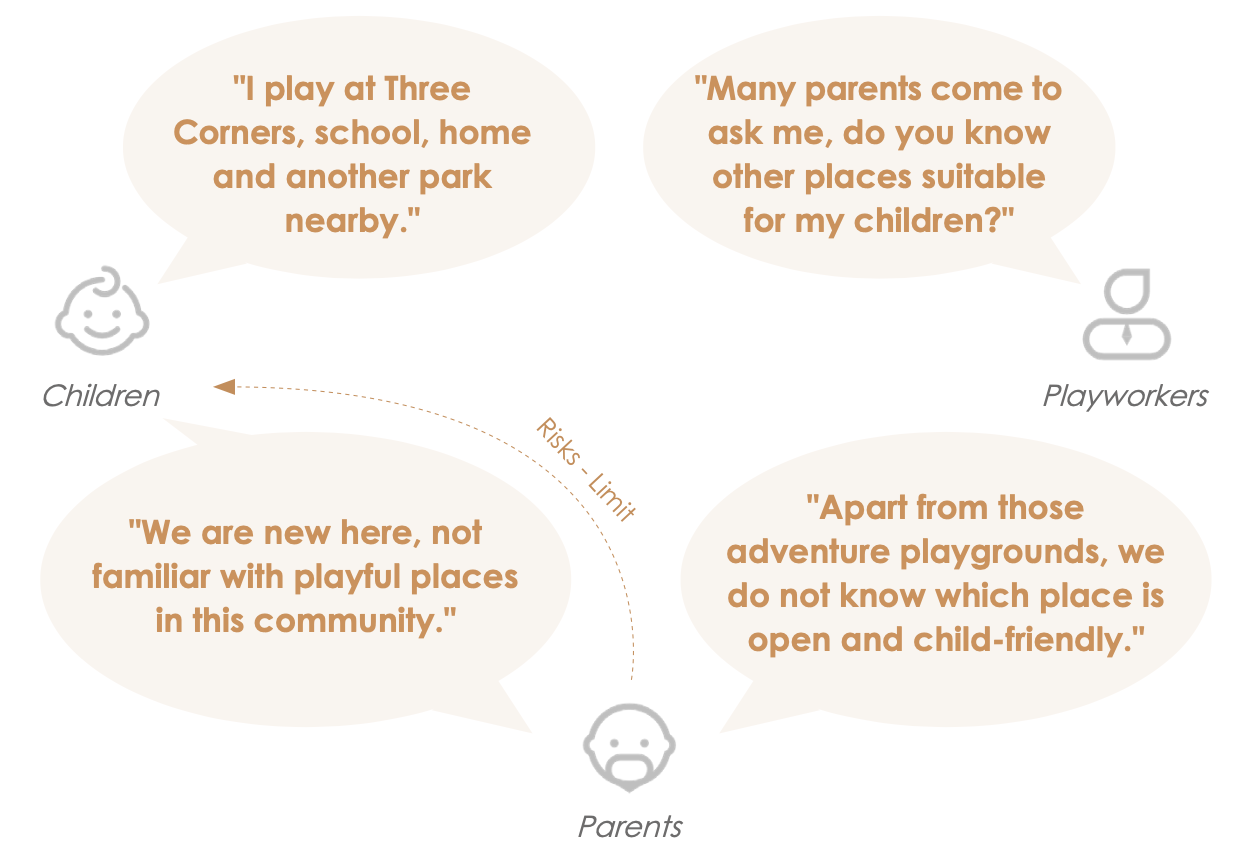
Challenge
Islington is a densely populated community and many children live in vulnerable overcrowded families, thus more play space is being called for. There are already many places to play in the community, and large playgrounds are only a small part of them. The real problem is that people, especially kids, don't know about these places and how playable they are.
How might we empower children to master the playability of their community?
Solution
Context
We designed Play@, a game-driven service targeting the kids aged 6 to 14 in the Islington community that can be practised by play organizations to unlock playable places, bridge different players in the community, and establish a playground-centred network.
In layman's terms, it is a toolkit that can be used by play organizations to transform real communities into games, which will map out all the playable spaces in the community and highlight the uniqueness of each place.
The partners of this project are London Play and Three Corners Adventure Playground. We have completed a round of testing and are now planning the next pilot.
Children need more places to play.
Islington is one of the most densely populated of London's 33 local authority areas, with around 104 people living on each football pitch-sized area of land. According to the Mayor of London, 43% of Islington children are living in poverty, thousands of homes are legally defined as ‘overcrowded’, many of them do not have gardens. So it seems like children & play is limited by the number/size of playable spaces and there is indeed a strong call for more play access in the community.
But in fact, according to the city plan of Islington Council, Islington already has 12 adventure playgrounds, and apart from hundreds of public green places, there are more than 400 hundred undesignated open spaces, such as community playgrounds, and open spaces in residential areas. So what is the real problem?
Problem definition
We do have a space issue, but most importantly, we have an awareness issue.
Partner: LONDON PLAY, Royal College of Art
Year: Oct-Dec 2022
Scope of work: Service design, Design research, Strategy planning
Tool: Figma, Adobe suite



Playable Open Space CardThere are two different kinds of plots on the map, the dark ones represent the playable open space, and the light ones represent the adventure playground that are well known to children.The player can choose whether to explore the area. If a playable public space is explored, one point of stamina is consumed, and the player can obtain two cards exclusive to the area. The upper left corner is the score, and the upper right corner is the element attribute, both of which are crucial to the final victory.Through observation & communication with children, and interviews with parents and playworkers, we found that the real problem is that people, especially children, are either not aware at all or know very little about other places to play in the community. Most children have their own fixed circle of play, and the boundaries of that circle are mostly home, school, and an adventure playground or two.
It is worth mentioning that adventure playgrounds, such as Three Corners, are well-known in the children's network because of their large area, diverse activities, and many challenging facilities, which also makes a considerable number of children not interested in public green spaces and other open spaces in residential areas without such engaging facilities.
'Children are the best players, and the most valuable thing in play is not the facilities and activities, but the exploration full of freedom'. Based on this principle, we define that what is missing is a cognition of the playability of the community, which is not only about 'where', but also 'what', 'when', and 'how'.
We do not aim to force children to jump out of the original play circle, but to know more, unlock more territories, and expand their own play world.
1: Play is limited by the awareness of where is playable.
2: Play is limited by original circle of play.
Strategy
Awareness of 'Where'
Provide a clarity about what places are open, playable, and child-friendly.
Awareness of 'What, When & How'
Provide a clarity about the uniquenesses of each playable place, including what facilities are there, who is playing, what will happen, etc,.
How might we empower children to master the playability of their community?
Solution
Step1: Map - Board Game
We integrated the information we want to pass on to children into a board game, and around "exploring as many and diverse places as possible", we have designed a competitive game mechanism similar to Monopoly.
- Design Process -
A map?
The easiest way to let others know where it is is to point it out on a map. We started with the Three Corners Adventure Playground(the partner that allows us to engage with kids and prototype iterations) and found and marked all playable public areas within a comfortable walking distance. But we found that kids there weren't interested in maps like this, let alone looking at specific places on them, and then we realized we were using the wrong language.
Adventure Playground CardIf the player chooses to explore the adventure playground, three stamina points will be consumed, and the player can get two exclusive cards for this area.It is worth mentioning that all the facilities and activities on the card come from reality and from the playable space that we researched and sampled.Unlucky areaThere will also be unexpected surprises on this map, such as 'Devil's Smile', which may burn a player's card, reduce a point of stamina, or even teleport the player back to the origin.Lucky area'Angel's Blessing' will bring good luck to players, such as increasing stamina, exchanging cards, setting traps, and more.Functional cardAmong the cards mined from the two types of plots, there will be functional cards that can help players protect themselves from the 'Devil's Smile'.An adventure map!
After the introduction of child-attractive elements, the original monotonous map suddenly became a prop that all adventurers wanted.
After 'Where', we began to think about how to let children know the uniqueness of each place where they can play. Simple labeling and preaching have been proved to be not effective methods, so maybe, using children's language and invisibly teaching through entertainment is the way to win.
- About Game Rule -







Step2: Worldview - Live Game
Board games convey information and let children have cognition, and we have designed a live game with a real world view and passport + seal as the core, managed by play organizations and large playgrounds, which can provide children with real and visible play channel.
- Field Participation -
Our aim was to create an engaging and enjoyable experience for children in playable spaces. Drawing inspiration from themed playgrounds and games, we recognized the importance of a compelling backstory and worldview to enhance immersion and purpose in play. To achieve this, we integrated a captivating narrative based on the renowned historical tale of the Three Corners adventure playground. Expanding this concept, we crafted a broader community story that encourages children and parents to embark on explorative tasks, fostering a desire for active involvement. This innovative approach effectively transforms the entire community into a dynamic playground.
The game's core mechanics involve obtaining a game manual from Three Corners, detailing the immersive world of the experience. Armed with passports and guided by a map, players venture out to discover designated exploration points, collecting stamps along the way. Upon completing the collection, players return to Three Corners to conclude the narrative and receive well-earned rewards.



Future development
London Play has agreed to continue the project with us and we are applying for government funding to print, distribute and pilot at other adventure playgrounds or the larger community.
Likewise, Three Corners Adventure Playground would like to continue promoting the game, and we are discussing whether we can produce a few copies ourselves and keep them in-house.
A game-driven service
This board game, as well as the Three Corners-centred live game, are just our test products on a small scale, actually, what we really want to deliver is a game builder that can be used by play organisations such as London Play, to improve the playability of different communities.
Finally, introduce Play@: A game-driven service for organizations to unlock playable places, bridge different players in the community, and establish a playground-centred network. It has two parts, a board game builder and a live game builder. The previous one can help turn the community into a board game, and the later one can help create a reality based worldview and turn the community into a live game.
Value proposition
Collaboration
London Play, a charity with the vision of "building a city where all children have the freedom to play”, acted as our academic partner, providing us with access to industry experts, playgrounds, and workshop opportunities throughout the whole process.
Three Corners Adventure Playground are our closest collaborators, providing us with volunteer opportunities to engage with kids and a proving ground for testing prototypes.
Play workers Kerri and Dom from Make-Do Play, an adventure playground offering free play activities for kids, also provided us with a wealth of industry insight.
Special thanks
We want to thank Andrei, Reece & Danny from Three Corners Adventure Playground, Kerri & Dom from Make-Do Play, a group of playworkers from Markfield, who shared their lived experience and insights with us;
Francesca & Guy from Awesome who provided us with their knowledge;
Paul, Jon, Caroline & Chrissy from London Play who with their expertise helped us make sense of it all!
John, Nicolas and Judah who give us guidance, advice and encouragement along the way.
Finally, we want to hug every child that we met through the whole journey!

















